parking brake BMW MOTORRAD F 650 CS 2003 Rider's Manual (in English)
[x] Cancel search | Manufacturer: BMW MOTORRAD, Model Year: 2003, Model line: , Model:Pages: 92, PDF Size: 6.48 MB
Page 46 of 92

44
Safety check
2
Checking lights
e Attention:
Always check that all lights are
in full working order before rid-
ing off.
L Note:
If turn indicator repeater flashes
at twice the usual speed:
Defective flasher bulb.
For instructions on changing
bulbs in parking light, headlight
(low beam and high beam), rear
light, brake light, turn indicators
and the number-plate light:
(
b Maintenance Instructions,
Chapter 2)
Headlight setting RHD/
LHD traffic
If the motorcycle is ridden in a
country where the opposite rule
of the road applies, its asym-
metric low-beam headlight will
tend to dazzle oncoming traffic.
Consult a specialist workshop,
preferably an authorised
BMW motorcycle dealer, to
have the headlight adjusted to
suit whichever rule of the road
applies.
e Attention:
Adhesive films with unsuitable
adhesives can damage the
headlight lens.
Lights
10K14bkg2.book Seite 44 Montag, 15. September 2003 5:30 17
Page 54 of 92

3
52
Starting – Riding – Parking
Placing motorcycle on
side stand
d Warning:
For safety reasons, never sit
on the motorcycle with the
side stand extended.
e Attention:
Stop the engine before using
the side stand.
Make sure the surface under
the stand is firm.
On a gradient, the motorcycle
should always face uphill; se-
lect 1st gear. Switch off the ignition
Keep both feet on the ground
Hold the left handlebar grip
with your left hand
Keep your right hand on the
right handlebar grip and the
handbrake lever
Hold the motorcycle upright and balanced
U s e y o u r le f t f o o t a t t h e e x t e n -
sion pin to extend the side
stand fully (arrow)
Slowly lean the motorcycle to the side until its weight is
taken by the stand and dis-
mount from the motorcycle
Turn the handlebars to full left
lock (
b9)
Check that the motorcycle
is firmly supported
Side stand
10K14bkg2.book Seite 52 Montag, 15. September 2003 5:30 17
Page 55 of 92
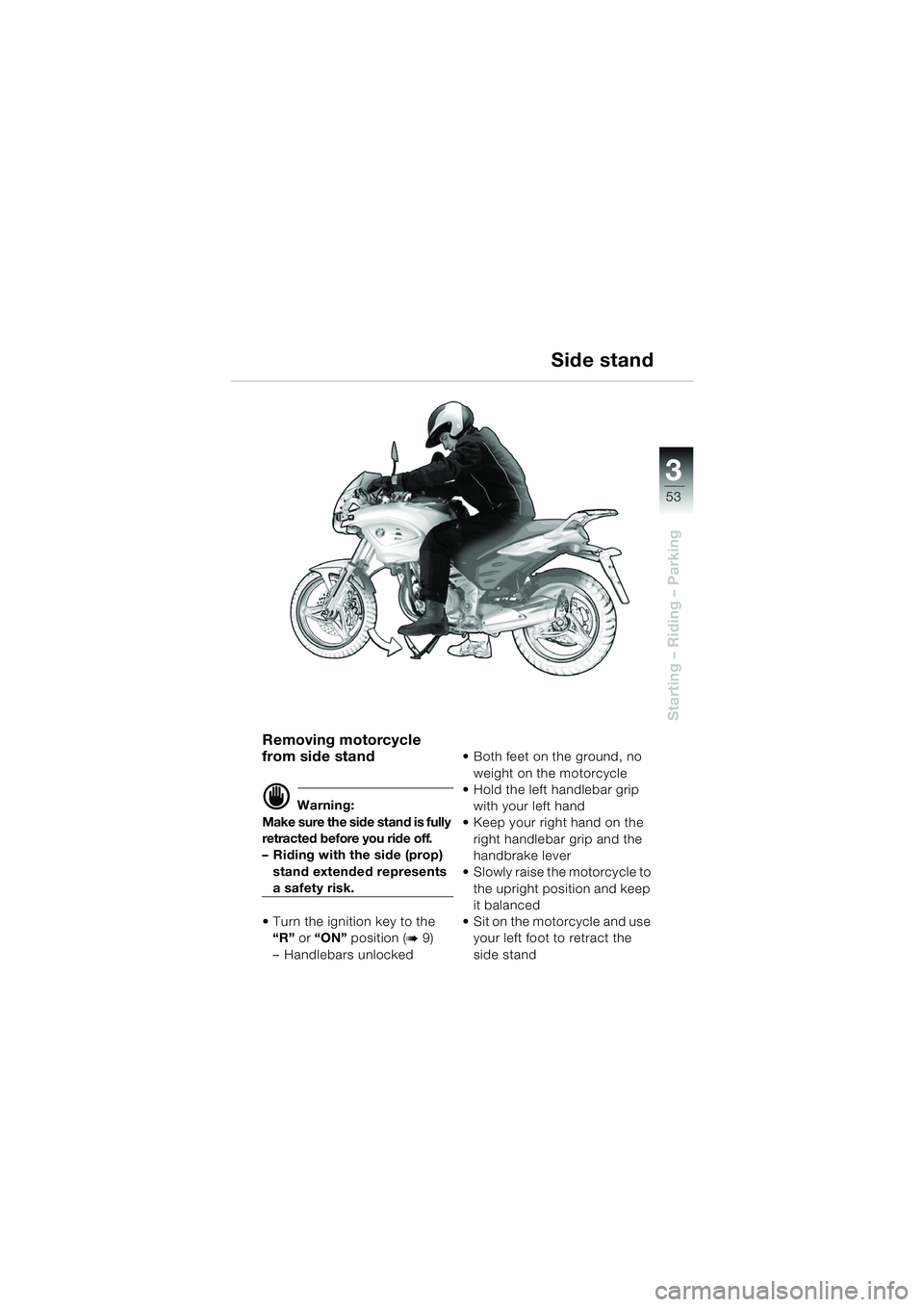
3
53
Starting – Riding – Parking
Removing motorcycle
from side stand
d Warning:
Make sure the side stand is fully
retracted before you ride off.
– Riding with the side (prop) stand extended represents
a safety risk.
Turn the ignition key to the “R” or “ON” position (
b9)
– Handlebars unlocked Both feet on the ground, no
weight on the motorcycle
Hold the left handlebar grip
with your left hand
Keep your right hand on the
right handlebar grip and the
handbrake lever
Slowly raise the motorcycle to
the upright position and keep
it balanced
Sit on the motorcycle and use your left foot to retract the
side stand
Side stand
10K14bkg2.book Seite 53 Montag, 15. September 2003 5:30 17
Page 57 of 92
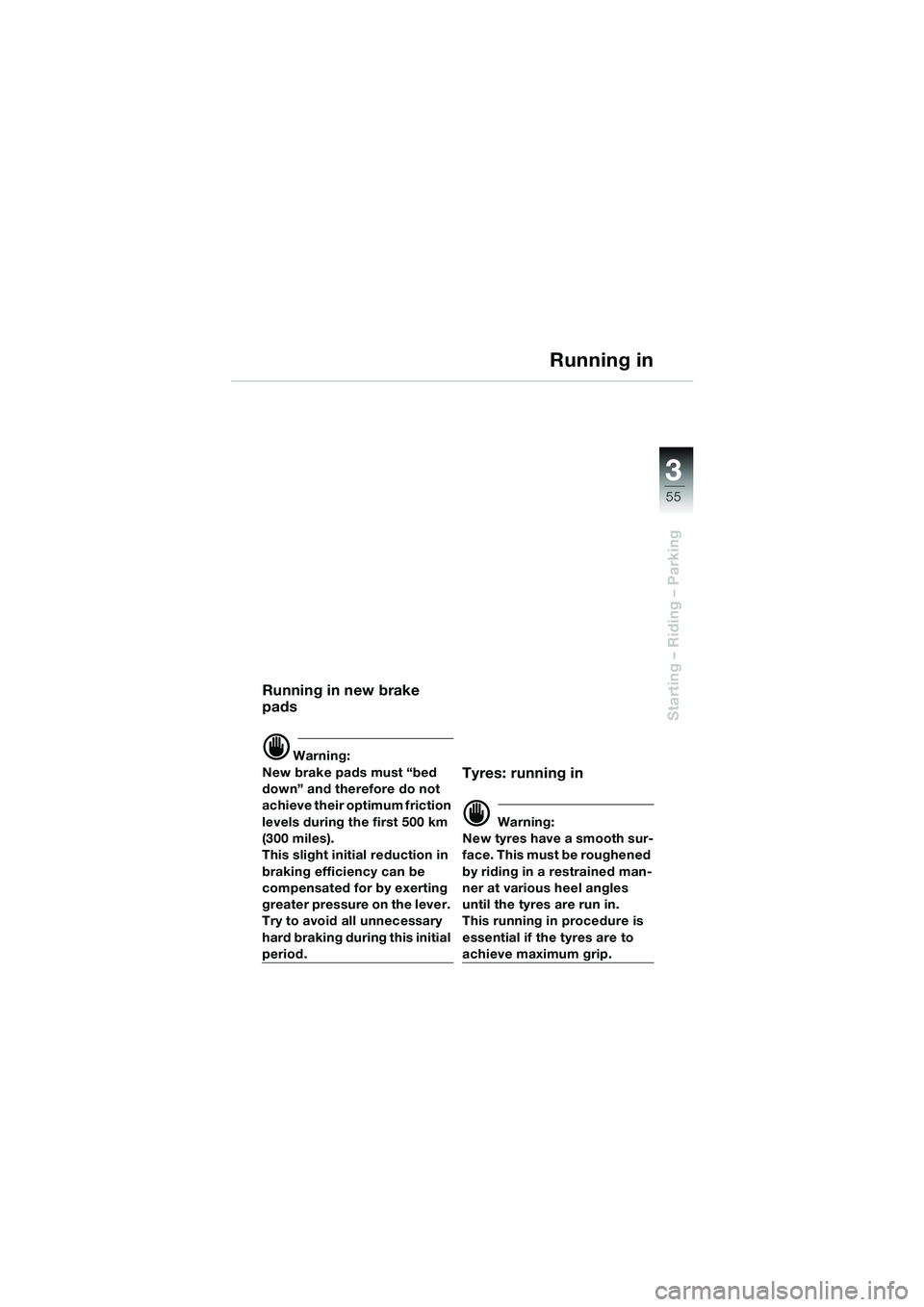
3
55
Starting – Riding – Parking
Running in
Running in new brake
pads
d Warning:
New brake pads must “bed
down” and therefore do not
achieve their optimum friction
levels during the first 500 km
(300 miles).
This slight initial reduction in
braking efficiency can be
compensated for by exerting
greater pressure on the lever.
Try to avoid all unnecessary
hard braking during this initial
period.
Tyres: running in
d Warning:
New tyres have a smooth sur-
face. This must be roughened
by riding in a restrained man-
ner at various heel angles
until the tyres are run in.
This running in procedure is
essential if the tyres are to
achieve maximum grip.
10K14bkg2.book Seite 55 Montag, 15. September 2003 5:30 17
Page 64 of 92
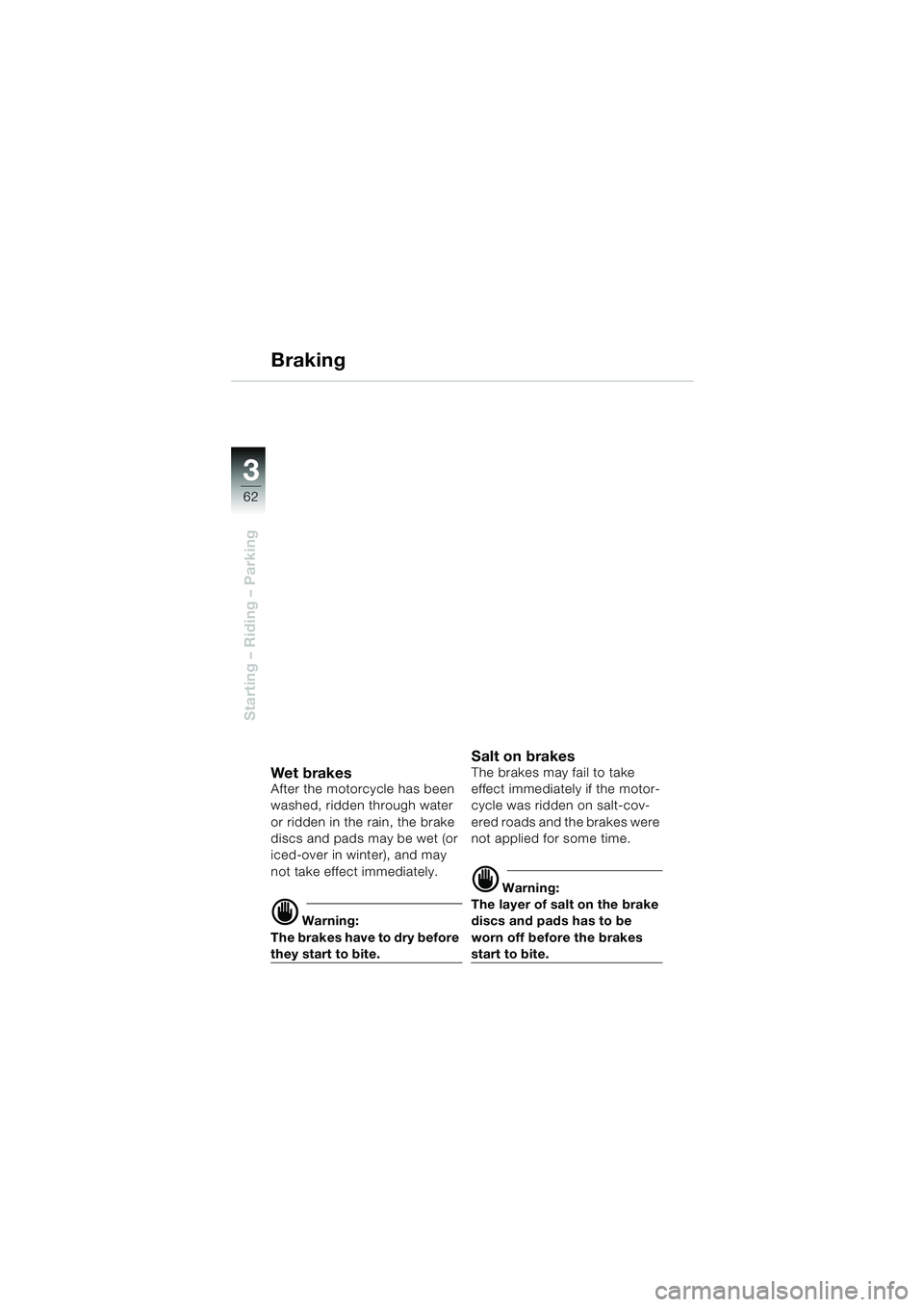
3
62
Starting – Riding – Parking
Braking
Wet bra kesAfter the motorcycle has been
washed, ridden through water
or ridden in the rain, the brake
discs and pads may be wet (or
iced-over in winter), and may
not take effect immediately.
d Warning:
The brakes have to dry before
they start to bite.
Salt on brakesThe brakes may fail to take
effect immediately if the motor-
cycle was ridden on salt-cov-
ered roads and the brakes were
not applied for some time.
d Warning:
The layer of salt on the brake
discs and pads has to be
worn off before the brakes
start to bite.
10K14bkg2.book Seite 62 Montag, 15. September 2003 5:30 17
Page 65 of 92
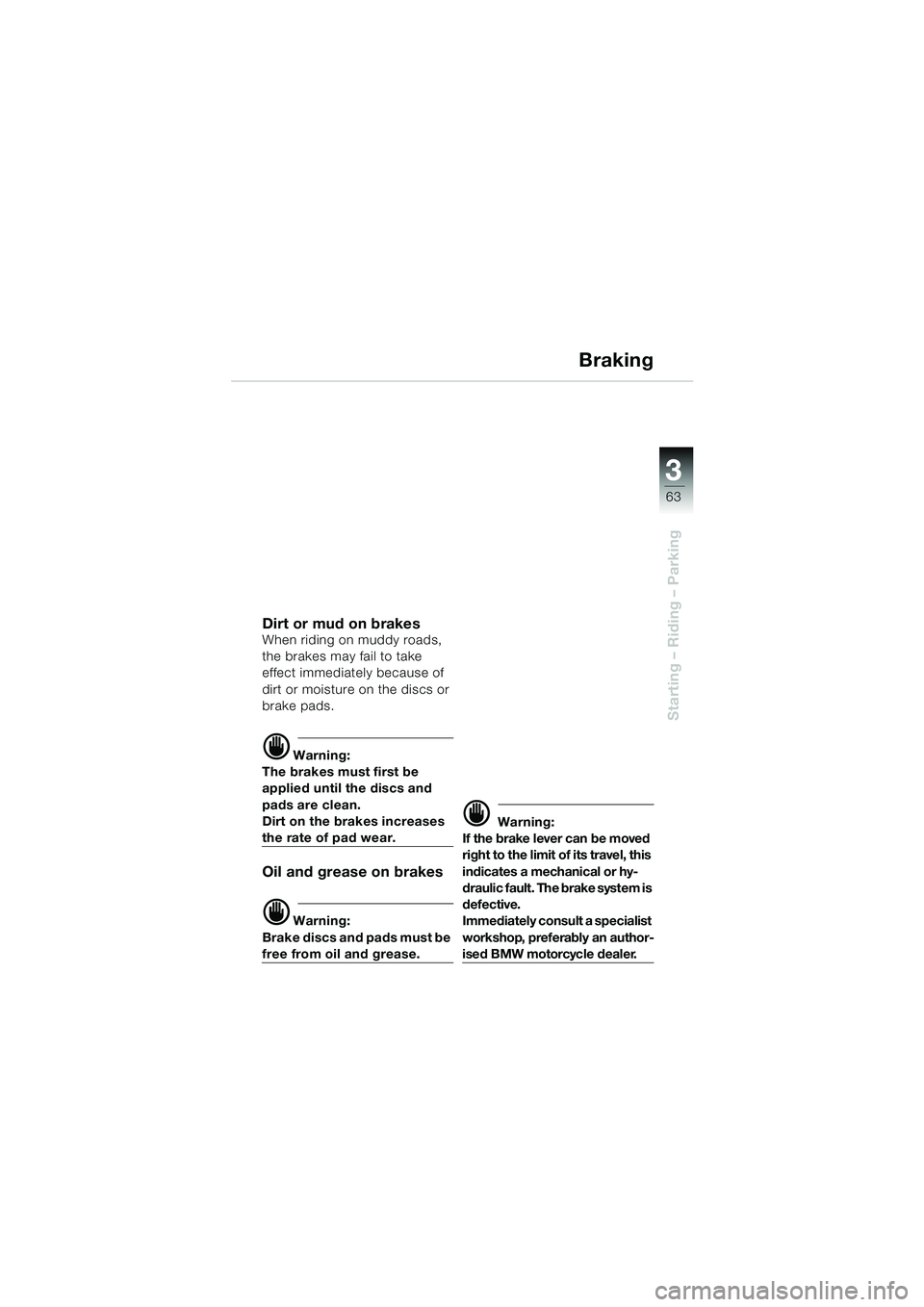
3
63
Starting – Riding – Parking
Braking
Dirt or mud on brakesWhen riding on muddy roads,
the brakes may fail to take
effect immediately because of
dirt or moisture on the discs or
brake pads.
d Warning:
The brakes must first be
applied until the discs and
pads are clean.
Dirt on the brakes increases
the rate of pad wear.
Oil and grease on brakes
d Warning:
Brake discs and pads must be
free from oil and grease.
d Warning:
If the brake lever can be moved
right to the limit of its travel, this
indicates a mechanical or hy-
draulic fault. The brake system is
defective.
Immediately consult a specialist
workshop, preferably an author-
ised BMW motorcycle dealer.
10K14bkg2.book Seite 63 Montag, 15. September 2003 5:30 17
Page 66 of 92
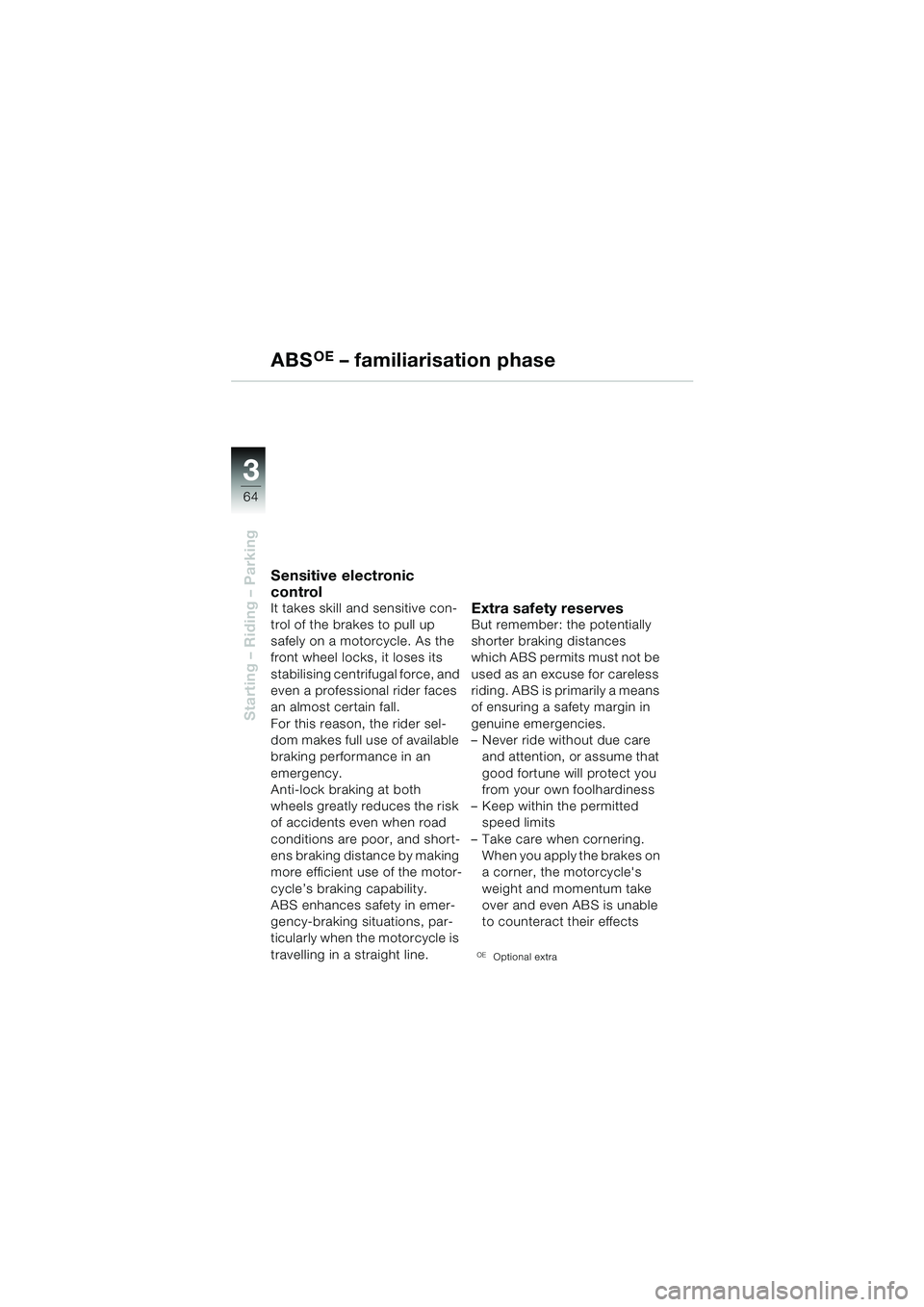
3
64
Starting – Riding – Parking
ABSOE – familiarisation phase
Sensitive electronic
control
It takes skill and sensitive con-
trol of the brakes to pull up
safely on a motorcycle. As the
front wheel locks, it loses its
stabilising centrifugal force, and
even a professional rider faces
an almost certain fall.
For this reason, the rider sel-
dom makes full use of available
braking performance in an
emergency.
Anti-lock braking at both
wheels greatly reduces the risk
of accidents even when road
conditions are poor, and short-
ens braking distance by making
more efficient use of the motor-
cycle’s braking capability.
ABS enhances safety in emer-
gency-braking situations, par-
ticularly when the motorcycle is
travelling in a straight line.Extra safety reservesBut remember: the potentially
shorter braking distances
which ABS permits must not be
used as an excuse for careless
riding. ABS is primarily a means
of ensuring a safety margin in
genuine emergencies.
– Never ride without due care and attention, or assume that
good fortune will protect you
from your own foolhardiness
– Keep within the permitted speed limits
– Take care when cornering. When you apply the brakes on
a corner, the motorcycle's
weight and momentum take
over and even ABS is unable
to counteract their effects
OEOptional extra
10K14bkg2.book Seite 64 Montag, 15. September 2003 5:30 17
Page 69 of 92
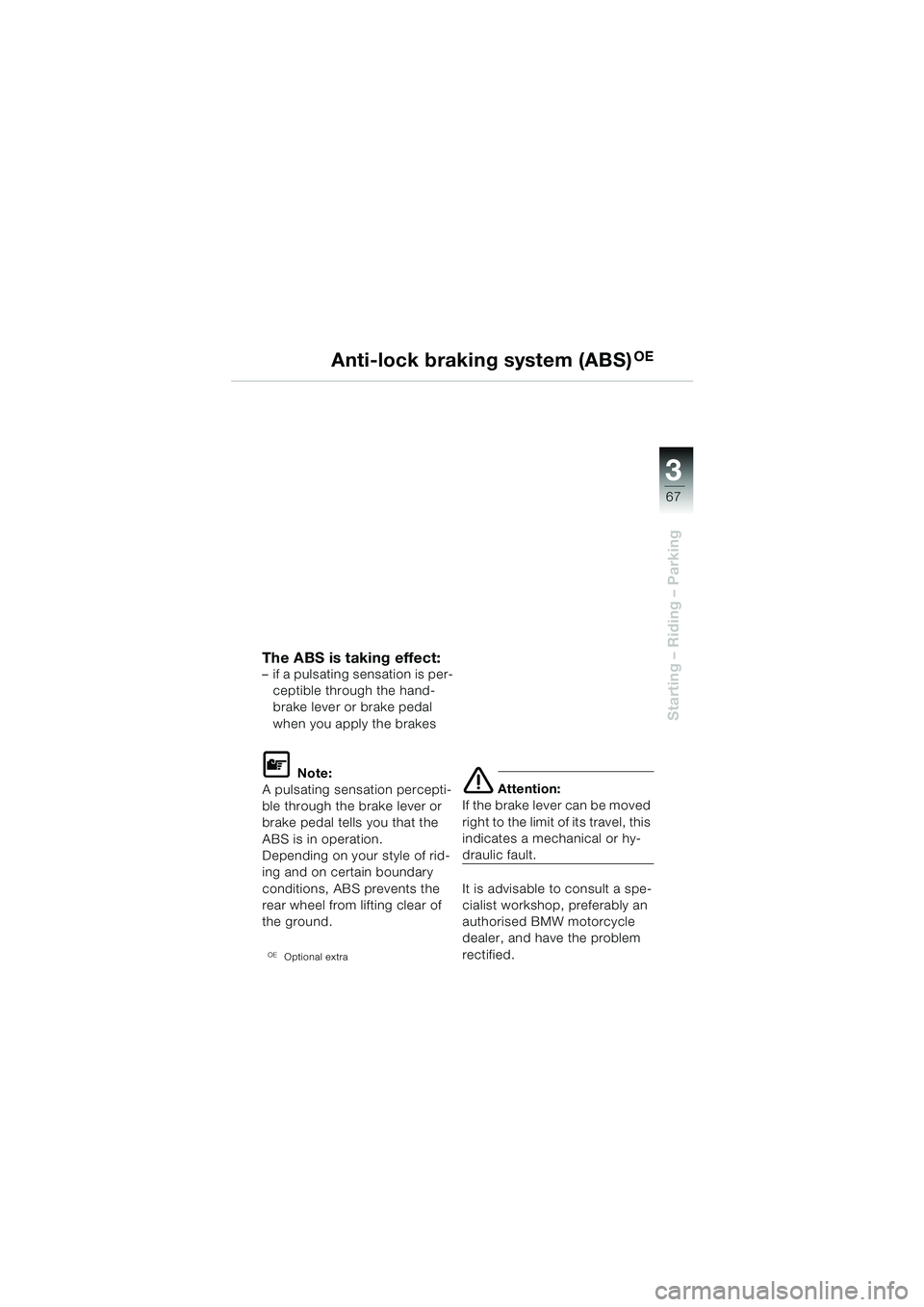
3
67
Starting – Riding – Parking
Anti-lock braking system (ABS)OE
The ABS is taking effect:– if a pulsating sensation is per-ceptible through the hand-
brake lever or brake pedal
when you apply the brakes
L Note:
A pulsating sensation percepti-
ble through the brake lever or
brake pedal tells you that the
ABS is in operation.
Depending on your style of rid-
ing and on certain boundary
conditions, ABS prevents the
rear wheel from lifting clear of
the ground.
OEOptional extra
e Attention:
If the brake lever can be moved
right to the limit of its travel, this
indicates a mechanical or hy-
draulic fault.
It is advisable to consult a spe-
cialist workshop, preferably an
authorised BMW motorcycle
dealer, and have the problem
rectified.
10K14bkg2.book Seite 67 Montag, 15. September 2003 5:30 17
Page 70 of 92
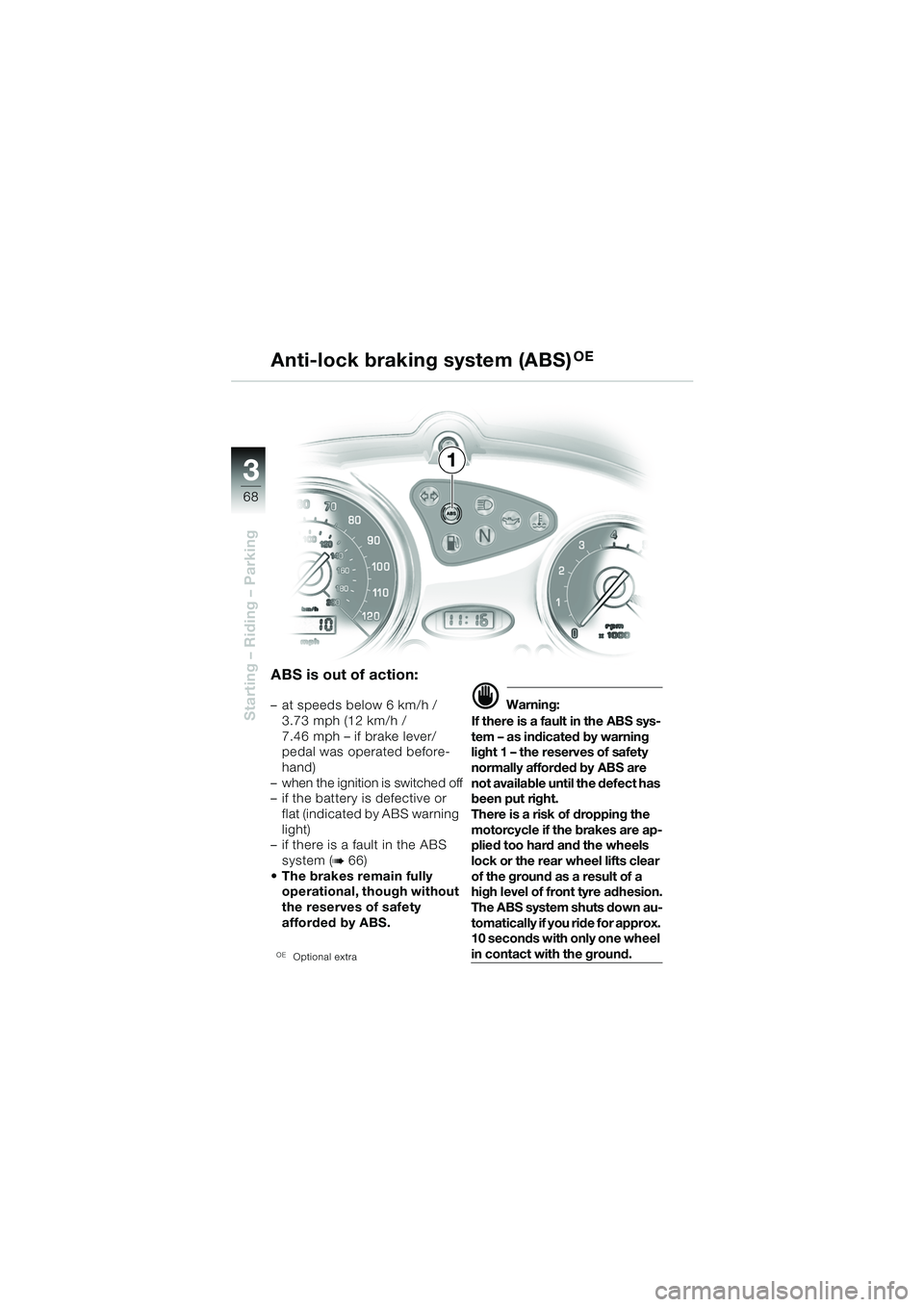
3
68
Starting – Riding – Parking
ABS is out of action:
– at speeds below 6 km/h / 3.73 mph (12 km/h /
7.46 mph – if brake lever/
pedal was operated before-
hand)
– when the ignition is switched off
– if the battery is defective or
flat (indicated by ABS warning
light)
– if there is a fault in the ABS
system (
b66)
The brakes remain fully operational, though without
the reserves of safety
afforded by ABS.
OEOptional extra
d Warning:
If there is a fault in the ABS sys-
tem – as indicated by warning
light 1 – the reserves of safety
normally afforded by ABS are
not available until the defect has
been put right.
There is a risk of dropping the
motorcycle if the brakes are ap-
plied too hard and the wheels
lock or the rear wheel lifts clear
of the ground as a result of a
high level of front tyre adhesion.
The ABS system shuts down au-
tomatically if you ride for approx.
10 seconds with only one wheel
in contact with the ground.
Anti-lock braking system (ABS)OE
1
10K14bkg2.book Seite 68 Montag, 15. September 2003 5:30 17